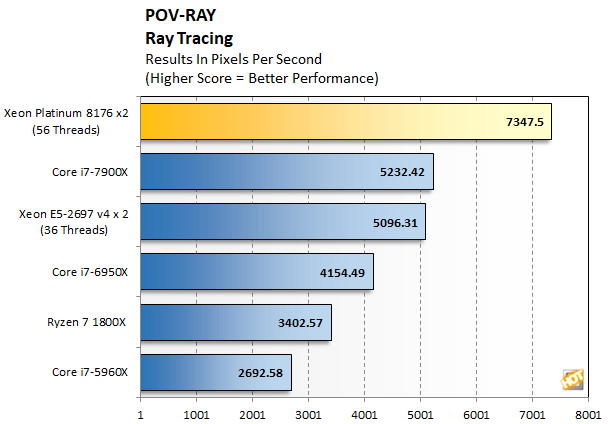Intel Xeon Scalable Debuts: Dual Xeon Platinum 8176 With 112 Threads Tested
Cinebench R15 is a 3D rendering performance test based on Cinema 4D from Maxon. Cinema 4D is a 3D rendering and animation suite used by animation houses and producers like Sony Animation and many others. Cinebench is very demanding of processor resources and is an excellent gauge of computational throughput.
|
This is a multi-threaded, multi-processor aware benchmark that renders a photorealistic 3D scene (from the viral "No Keyframes" animation by AixSponza). This scene makes use of various algorithms to stress all available processor cores. The rate at which each test system was able to render the entire scene is represented in the graph below.

We've included a single-core result here to show any generational improvements between Broadwell and Skylake. As you can see, the new Xeon Platinum 8176-based server offers significantly better performance than the previous generation E5-2697 v4-based machine, in both single and multi-threaded workloads.
|
POV-Ray, or the Persistence of Vision Ray-Tracer, is an open source tool for creating realistically lit 3D graphics artwork. We tested with POV-Ray's standard 'all-CPU' benchmark option on our test machines, and recorded the scores reported for each. Results are measured in pixels-per-second throughput; higher scores equate to better performance.

POV-RAY would only leverage all of the physical cores in the servers, which left all of the logical processors idle during the benchmark, whereas all-cores were utilized in the desktop platforms. Keep that in mind looking at these results. We've included some HEDT results simply for reference and to provide more context and data. Regardless, the Xeon Platinum 8176-based server dominates here, as you would expect given the immense amount of compute performance at its disposal.
|
Blender is a free and open source 3D creation suite that can handle everything from modeling, rigging, animation, simulation, rendering, compositing and motion tracking, even video editing and game creation. It has a built-in benchmarking tool that will track the time it takes to complete rendering a particular model. We used a CPU-focused BMW model for these tests here...

The Xeon Platinum 8176-based server similarly dominated here. The additional compute performance offered by the 112-threads pushed the Xeon Platinum 8176-based machine well into the lead.
|
STARS Euler3d is a computational fluid dynamics benchmark which uses a CFD grid that contains 1.23 million tetrahedral elements and 223 thousand nodes. The benchmark executable advances a mach 0.50 Advisory Group for Aerospace Research, or AGARD, flow solution for an aeroelastic test wing. The benchmark score is reported as a CFD cycle frequency in Hertz.

Results in this benchmark are heavily influenced by platform bandwidth, in addition to available compute resources, so the spread separating the systems is somewhat tighter. Still, Intel's new server platform takes the pole position, by a relatively wide margin.
|
|
|

This power consumption data tells an interesting story in our opinion. In terms of absolutes, nothing appears to be out of the ordinary. We have seen many powerful test systems idle in the sub-200 watt range, and have seen peak power consumption much higher than 505 watts, especially when testing high-end systems with multiple GPUs. However, none of those systems had 56 physical CPU cores and 384GB of RAM. Considering the horsepower of this 2P Xeon Platinum 8176-based server, that fact that it pulls only 580 watts from the wall under load is quite impressive.

What's perhaps more interesting is the comparison to the 2P Xeon E5-2697 v4 based machine. The 2P Xeon Platinum 8176 system -- despite having more memory (384GB vs. 256GB) and more cores (56 vs. 36) -- actually pulled less power at idle or with only a single-core being taxed. And with all cores / threads being utilized the Xeon Platinum 8176-based machine used only marginally more power. Looking back at the significantly better performance offered by the Xeon Platinums, their higher peak power consumption is easily justified.






